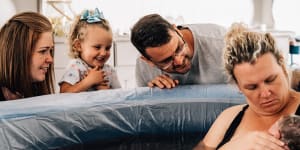A mother should be supported to birth wherever she feels safe and for many that is in the comfort of their own home.

Elisha Rose gave birth to her son at home.Cat Fancote
In WA if you wish to birth at home with a midwife in attendance,a planned home birth,you can either engage a private midwife or apply to the Community Midwifery Program run by various hospitals.
Regionally,some hospitals also have a Midwifery Group Programs that also support planned home birth.
While both programs are free,they have strict eligibility criteria and often women are excluded with little evidence-based research to support their exclusion.
For women wanting a planned home birth,this leaves the option of engaging a private midwife,with most costing around $7500.
If you get a referral from your GP for a private midwife you are eligible for a modest rebate from Medicare of around $1500,meaning that the option of using a private midwife is financially out of reach for many.
This is often when women turn to free birth. That is birthing without a medically trained professional to support the birthing woman and baby.
Women who choose to free birth sometimes feel that they are left with few options. They are fearful of a hospital birth or hospital homebirth programs and can’t afford to pay a private midwife.
Some women also deliberately choose to free birth,relying on their bodily autonomy and intuition to guide them. Women who choose to free birth should be respected;they do not make the decision lightly and often have done considerable research on the risks and benefits.
The benefit of engaging a midwife privately for a planned home birth is the amazing continuity of care provided to support the birthing woman through her pregnancy,birth and for six weeks postpartum.
“My own homebirth was the most incredible experience. I long to do it over again. It was peaceful,mother-led,respectful and restorative.”
The midwife is able to prescribe medications,write referrals for diagnostic tests and scans and attends the birth with a back-up midwife,emergency drugs/equipment and oxygen in case of emergencies. Most private midwives also require you to have ambulance cover in case there is a need to transfer to hospital.
Whatever model of planned home birth,there is a shortage of spots. Before you even have your mind wrapped around the babe growing inside you,you must immediately register with your chosen care provider. Both the CMP and private midwives book out almost immediately. In fact,I contacted my private midwife before I was even pregnant so that she knew a booking was to be expected.
Planned home birth is safe,in fact it is very safe. It often has better outcomes than hospital births and there is much evidence to support this.
,a 2018 analysis of both low and high-risk women planning a home vs hospital birth found “planned home birth was associated with significantly higher rates of spontaneous vaginal birth,significantly lower rates of all obstetric interventions and significantly lower perinatal and maternal morbidities”. It is simply not true that planned home birth is unsafe.
My own home birth was the most incredible experience. I long to do it over again. It was peaceful,mother-led,respectful and restorative. It was a far cry from my birthing centre birth where I was restricted by hospital policy and forced into interventions I did not need or want leading to birth trauma.

Elisha Rose gave birth to her son at home. Picture:Cat FancoteCat Fancote
My home birth was especially normal. My husband did the school run,he came back to me in established labour,my birthing team arrived around 10am (two midwives,doula,birth photographer and my best friend),the birth pool was inflated and filled,I entered the water around 11am having increasingly intense surges and I gently brought my baby earthside around noon,following my own intuition.
No drugs,no interventions and on my own terms. My daughter watched her baby brother enter the world and by the time my older kids got home from school I was sitting up in bed,feeding my baby and sipping on soup cooked by my doula. My recovery was remarkably short,I was supported by my doula and midwives for six weeks after birth including home-cooked meals for my family,assistance to breastfeed and knitted baby goods. I felt so cared for and respected at all stages.
Birth trauma is very real and affects many women in Australia. The statistics are horrifying,with one in three women describing their birth experience as traumatising,.
Undoubtedly the lack of respect for birthing women and their autonomy that many experience in hospital settings,including obstetric violence and unnecessary interventions,has led to an increase in birth trauma which can sometimes carry on to become postpartum depression and anxiety. It is these well-documented outcomes that lead women to choose to birth outside of a hospital setting.
There is a small but passionate movement among women for better choice in birthing.
New Zealand and the United Kingdom have excellent,publicly funded homebirth programs which are accessible to many,yet in Australia it is reserved for the few who are eligible or those who can afford a private midwife.
Even now,despite a full crowd being allowed in to watch a football game at Optus Stadium,there are still COVID restrictions blocking women from having anyone other than their partner present to support them during their hospital births (and they are only permitted to attend once the woman is in established labour).
The release in 2021 of the award-winning Australian documentaryBirth Time highlights the better outcomes for women when they home birth with a known and consistent midwife who cares for them during pregnancy,birth and the postpartum period.
‘One woman,one midwife’ is the gold standard and should be an accessible option for all women in Australia.
Follow WAtoday on,, and for handpicked selections of the day’s biggest local,national and international news.